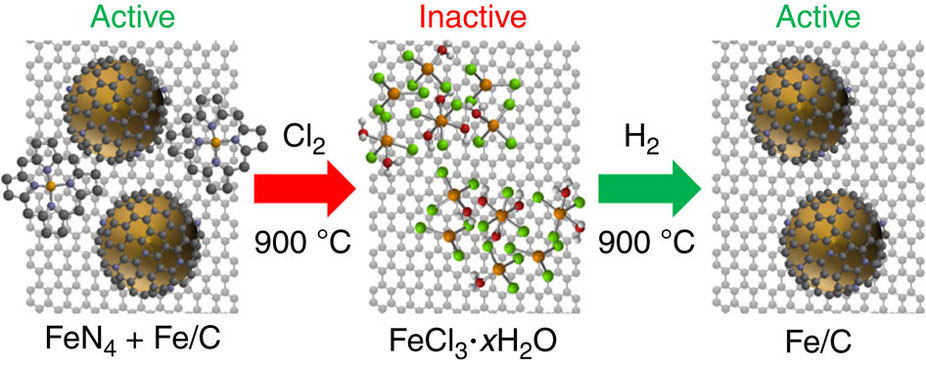非貴金属酸素還元触媒の活性種としての炭素封入鉄ナノ粒子の特定
Identification of carbon-encapsulated iron nanoparticles as active species in non-precious metal oxygen reduction catalysts
2016年8月19日 Nature Communications 7 : 12582 doi: 10.1038/ncomms12582

効率と費用効果の高い酸素還元反応の触媒がないため、燃料電池は今のところあまり普及していない。鉄系非貴金属触媒は、最先端の白金触媒の代替として、有望な活性と安定性を示す。しかし、非金属触媒における活性種に固有の特徴はまだよくわかっておらず、新しい触媒の開発を妨げている。今回我々は、鉄系非貴金属酸素還元触媒の可逆的な非活性化と再活性化を、塩素と水素による高温気相処理を用いて実現したことを報告する。さらに我々は、メスバウアー分光法とX線吸収分光法を用いて、塩素処理と水素処理の後に触媒の不均一性が低下していることを観測した。観測された触媒の活性と安定性が、鉄ナノ粒子の近傍にある保護部位に起因することが、今回の研究によって明らかになった。こうした知見によって、活性部位の密度が高い改良型の非貴金属酸素還元触媒の設計と合成が可能になるかもしれない。
Corresponding Author
The widespread use of fuel cells is currently limited by the lack of efficient and cost-effective catalysts for the oxygen reduction reaction. Iron-based non-precious metal catalysts exhibit promising activity and stability, as an alternative to state-of-the-art platinum catalysts. However, the identity of the active species in non-precious metal catalysts remains elusive, impeding the development of new catalysts. Here we demonstrate the reversible deactivation and reactivation of an iron-based non-precious metal oxygen reduction catalyst achieved using high-temperature gas-phase chlorine and hydrogen treatments. In addition, we observe a decrease in catalyst heterogeneity following treatment with chlorine and hydrogen, using Mössbauer and X-ray absorption spectroscopy. Our study reveals that protected sites adjacent to iron nanoparticles are responsible for the observed activity and stability of the catalyst. These findings may allow for the design and synthesis of enhanced non-precious metal oxygen reduction catalysts with a higher density of active sites.

